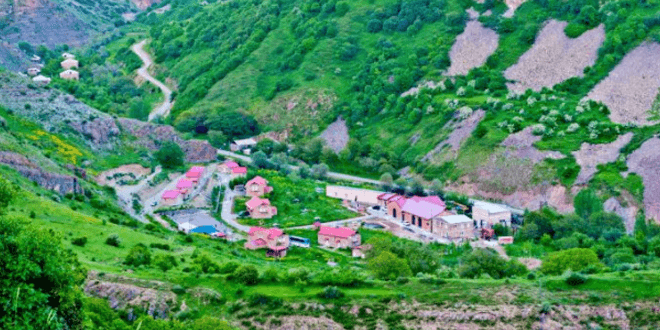Vayots Dzor Region


Area: 2,308 km2
Population: 52,324 (2011)
Vayots Dzor is located in the southeastern part of Armenia. It borders on Nakhichevan in the west and the Kalbajar District in the east. Vayots Dzor is surrounded by high mountains and mountain chains that make natural barriers for its neighboring areas. The region has rich flora and fauna.
The Province of Vayots Dzor has the least number of population in Armenia. The three important towns are Yeghegnadzor, Jermuk, and Vayk. The people here are very conservative: they celebrate nearly all the religious and traditional festivals. The most famous celebration is the harvest festival which takes place every year on the second Sunday of October.
Yeghegnadzor is the historic and cultural centre of Vayots Dzor. It is one of the oldest residences in Armenia which is situated on the right bank of the River Arpa. The city’s name was first mentioned in the 7th century. For some period of time it was known as Mikoyan; in honour of Great Armenian politician Anastas Mikoyan.
Historical Sights of Vayots Dzor
Noravank Monastery
The most popular place in Vayots Dzor is the Noravank Monastery of the 13th century. The monastic complex includes the church of St. Karapet, St. Grigor chapel and the church of St. Astvatsatsin (Holy Mother of God).
The monastery is best known for its two-storey Surb Astvatsatsin Church which was completed in 1339. The monastery is a masterpiece created by the talented sculptor and miniaturist Momik. Noravank is the last work of the master, who died the same year Noravank was completed and was buried at the church.
In 2002 the Monastery of Noravank was included in the UNESCO World Heritage List.
Jermuk Waterfall
The second important town in Vayots Dzor is Jermuk - the most famous and popular sanatorium in Armenia. It is surrounded by mountains and thick forests. Jermuk is rich with fresh and mineral water springs. There is also an underground geyser used for drinking and taking baths. It cures various diseases and neurological disorders.
The waterfall of Jermuk is a must-see attraction of Vayots Dzor. It is the second-largest waterfall in Armenia (70 meters). Together with the picturesque surroundings, the waterfall makes an impressive view.
Kechut Reservoir
3.5 km to the South from Jermuk, on the river Arpa, Kechut Water Reservoir is located. It was built in 1981 to regulate the water level of Lake Sevan.
The population of Vayots Dzor Region
According to the census of 2011, only 52 324 people live in the province of Vayots Dzor: 99.74 % Armenians, 0.15% Russians, 0.04 % Ukrainians.
Yeghegnadzor

Yeghegnadzor is the administrative centre of Vayots Dzor Region. It is situated in the southeastern part of Armenia on the banks of the Srkghonk River, a tributary of the Arpa River. The city is 123 km south of the capital Yerevan, at the height of 1194 meters above sea level. The climate is mild with snowy winters and warm summers.
History of Yeghegnadzor
The name of the city consists of two Armenian words: "yegheg" meaning "cane" and "dzor" meaning "valley", so the name means "valley of canes". It is one of the oldest residences of Armenia. The city was first mentioned in the 5th century. It belonged to the Vayots Dzor canton of Syunik which was the 9th province of Great Armenia.
Many churches, monastic complexes, bridges and caravanserais were built in the city during the 10th-13th centuries.
In 1747, when Eastern Armenia was still under Iranian rule, the city became part of Nakhichevan Khanate and was known as Keshishkend. In 1935 it was renamed Mikoyan after the politician and Bolshevik leader Anastas Mikoyan. In 1956 the town got its present name.
Sights of Yeghegnadzor
Yeghegnadzor is the historical and cultural centre of Vayots Dzor. Many ancient churches are located here. The most popular place in the town is the Noravank Monastery of the 13th-14th centuries. Zorats St. Astvatsatsin Church (Holy Mother of God) is another work of art to see in Yeghegnadzor.
The Cathedral of the Holy Mother of God of the 12th century (also known as St. Sarkis) serves as the seat of the Vayots Dzor Diocese of the Armenian Apostolic Church.
Not far from the town of Yeghegnadzor is Spitakavor Monastery of the Holy Mother of God which was built in 1321. It is a remarkable monastery isolated in nature with the stunning surrounding scenery. The remains of the Armenian national hero and military leader Garegin Nzhdeh were secretly buried in the yard of Spitakavor Monastery in the 1980s. He had died in a Soviet prison in 1955.
The historic University of Gladzor of the 13th century was located at the outskirts of Yeghegnadzor. It was a great centre of learning which operated until 1340.
In 1984 on the 700th anniversary of Gladzor University, the Historic-Cultural Preserve-Museum of Gladzor University was established in the historic church of Surb Hakob (St. Jacob) in Vernashen village.
There is also an archaeological museum in the town, as well as an art school, a sports school and a musical academy.
The popular harvest festival takes place in Yeghegnadzor every year on the second Sunday of October.
City/town
Sights
Noravank Monastery
Noravank is a monastery complex which was built in the13th -14th centuries. It is located near Amaghu town, Vayots Dzor Region. According to Stepanos Orbelian, the church was a sanctuary. In the beginning of the 13th century, Noravank was the spiritual center of Syunik Region.
Read More


